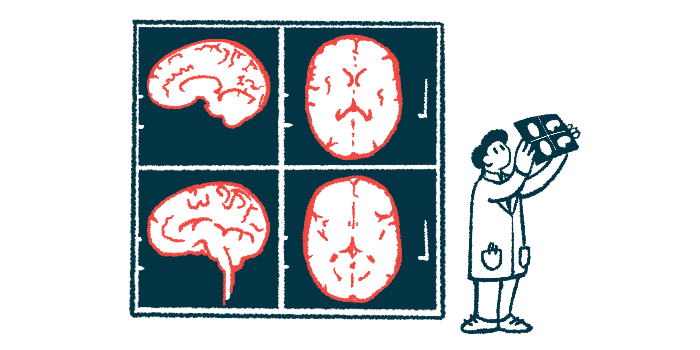Autoimmune encephalitis, while rare, complicates LEMS’ course
Brain inflammation found in man who responded poorly to LEMS treatment

In an elderly man, Lambert–Eaton myasthenic syndrome (LEMS) was complicated by overlapping symptoms of autoimmune encephalitis, a type of brain inflammation caused by self-reactive antibodies, according to a report from Japan.
“When atypical symptoms occur in patients with LEMS, it is important to consider the possibility of concomitant autoimmune encephalitis,” the scientists wrote in their report, “Lambert-Eaton Myasthenic Syndrome Complicated by anti-GABAB Receptor Encephalitis,” published in Internal Medicine.
LEMS, an autoimmune disease, occurs when self-reactive antibodies mistakenly attack voltage-gated calcium channel (VGCC) proteins at the point of near contact between nerve cells and muscles, where they release signals to communicate.
As such, the abnormal immune attack impairs nerve-muscle communication, causing such disease symptoms as muscle weakness and trouble walking, breathing, and seeing.
“Approximately 60% of LEMS cases are associated with tumors, most of which are small-cell lung carcinomas (SCLC),” the researchers wrote. SCLC is a usually fast-growing cancer that forms in the lungs.
LEMS often linked to lung cancer, more rarely to other autoimmune diseases
More rarely, LEMS can co-occur with another autoimmune disease.
Scientists in Japan described the case of a 74-year-old man with hard-to-treat LEMS that was later found to be complicated by autoimmune encephalitis.
The man, who was a heavy smoker for more than 50 years, visited a hospital with complaints of double vision, rapid unexplained weight loss, and generalized muscle weakness that had mainly affected the left side of his body for several months.
Given that the causes for his symptoms were unclear, he was first diagnosed with frailty. As muscle weakness worsened, he also experienced speaking and swallowing difficulties, prompting a re-evaluation.
Blood testing came back positive for antibodies against VGCC, “raising the suspicion of LEMS,” the team wrote.
The man was referred to the scientists’ hospital, where a physical examination revealed movement problems in his right eye and poor reflexes that improved after exercise — a common finding in LEMS.
He also had trouble with getting and maintaining an erection, suggesting problems in the autonomic nervous system that controls involuntary body functions like heartbeat and blood pressure.
Tumor marker levels were within the normal range and a whole-body computed tomography scan was clear. There were “no apparent [cancerous] tumors,” the scientists wrote.
A nerve conduction test revealed that signals traveling down the left and right ulnar nerves, which run from the shoulders to the hands, were weaker than normal. These signals grew stronger after a brief exercise stint.
Firdapse and plasma exchange fail to ease man’s muscle weakness
Based on these findings, he was diagnosed with LEMS.
Before initiating treatment, however, the man developed acute respiratory failure, which happens when the lungs cannot deliver enough oxygen to the blood. He was placed on mechanical ventilation to help with breathing.
He was treated with Firdapse (amifampridine), an approved LEMS medication that helps restore nerve-muscle communication, and given plasmapheresis to remove disease-causing antibodies from the blood.
These treatments did not ease his muscle weakness and respiratory difficulties, and additional symptoms developed, including central sleep apnea and hallucinations. Central sleep apnea is a condition characterized by repeated interruptions in breathing during sleep.
While these new symptoms suggested the brain involvement, brain scans “did not reveal any significant abnormalities,” the scientists wrote.
Treatment with intravenous immunoglobulin to block self-reactive antibodies, as well as high-dose methylprednisolone and oral prednisolone to suppress immune attacks, did not bring any improvements, “and no further immunotherapy was administered,” the scientists wrote.
Further testing revealed the presence of antibodies against the GABAB receptor protein in the blood and cerebrospinal fluid, the liquid that surrounds the brain and spinal cord, indicating the simultaneous presence of autoimmune encephalitis.
In adults, the GABAB receptor at the surface of nerve cells helps to protect the brain from being overloaded with too many signals. Self-reactive antibodies against it reduce its activity, causing brain inflammation, seizures, memory loss, confusion, and psychiatric symptoms.
GABAB receptor-related autoimmune encephalitis also can cause central sleep apnea and, in severe cases, respiratory arrest.
“Chronic respiratory muscle weakness due to LEMS, combined with central apnea due to anti-GABAB receptor encephalitis, is presumed to result in acute respiratory failure,” the team wrote, adding that “when acute respiratory failure occurs in LEMS, and the cause is unknown, concomitant autoimmune encephalitis should be considered.”
GABAB receptor-related autoimmune encephalitis is linked to cancer in more than half of its cases, mostly SCLC. The scientists suspected the man also had such a cancer but they were unable to detect it.
Antibodies against the GABAB receptor have been reported in about 13% of LEMS patients, they noted, adding that cases of LEMS complicated by GABAB receptor-related encephalitis “are extremely rare, and to our knowledge, only two such cases have been reported.”
“The symptoms of LEMS may worsen due to concomitant autoimmune encephalitis, necessitating aggressive immunotherapy and frequent screening for malignant tumors,” the scientists concluded.







